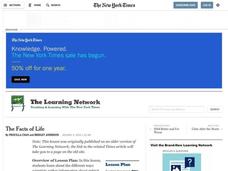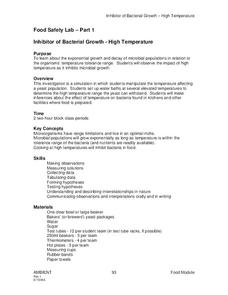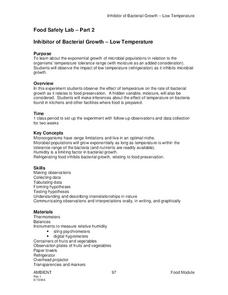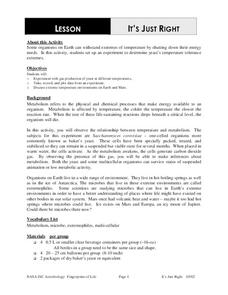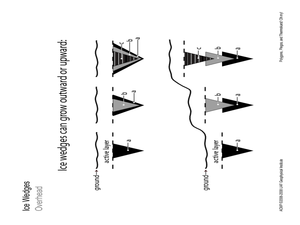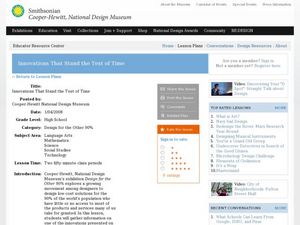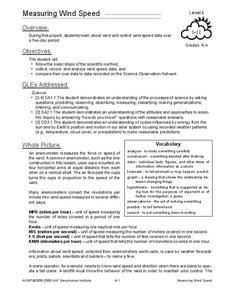Curated OER
Bacterial growth
Students explore the exponential growth and decay of microbial populations in relation to the organism tolerance ranges in their environment, They observe the impact of changing variables which can affect microbial populations.
Curated OER
The Facts of Life
Students explore the different ways scientists gather information about extinct animals. They utilize these methods to create illustrated story books about a particular extinct animal.
Curated OER
Scientific Method
Students examine the steps of the scientific method. They define related vocabulary terms, view a PowerPoint presentation, and apply and identify the steps of the scientific method for an online experiment scenario.
Curated OER
Activity #1 Reactions: Chemical or Physical?
Students distinguish between physical changes and chemical changes. They comprehend that chemical reactions produce new substances with compositions and properites which are different than those of the starting materials. Pupils also...
Curated OER
Activity #4 What Do Equations Mean?
Learners practice with writing and balancing simple chemcial equations. they comprehend that chemical equations are a method of using a set of univeral symbols to represent what happens experimentally in chemical reactions. Pupils...
Curated OER
Activity #3 Are Particles "Real?"
Students verbalize a simple particle theory, They apply their particle theory to explain what happens during chemical reactions and how this theory supports the law of conservation of matter. Pupils comprehend that the atomic theory,...
Curated OER
(Clues to) Copying the Codes: Examining the Evidence
Students view animations of DNA replication and transcription and complete a worksheet. In this genetics lesson, after watching on-line video clips to gather information about DNA replication and transcription, student teams identify...
Curated OER
Food Safety Lab
Learners determine the optimal living conditions for yeast and apply these results to microbes in food. For this microbiology lab lesson, students observe the reaction of yeast to elevated temperatures. They relate these results to safe...
Curated OER
Food Safety Lab
Students use the scientific method to investigate the role of temperature in microbial growth. In this food preservation lesson, students set up an experiment with fruit in room temperature and in a refrigerator. They record the...
Curated OER
It's Just Right
Students conduct an experiment to determine the temperature tolerance of yeasts. In this biology lesson, students collect data and compare them by plotting graphs. They explain how extreme temperatures affect organisms.
Curated OER
Mass Measurement
Middle schoolers explore geometry by completing a physics activity on-line. In this mass measurement lesson, pupils define the terms mass, volume, and density and identify their relationship with each other. They complete an on-line...
Curated OER
Zoo Animal Experts
As part of an exploration of zoo animals, kindergarteners conduct research on their favorite animal and compile their information. Learners write about their animal in a journal and create a trading card. The culminating activity is a...
Curated OER
How Can You Study Things You Can’t See Like: Atoms?
Students simulate how scientists studied things they can't see like atoms. In this chemistry lesson plan, students predict what is inside the numbered obsertainers. They design a way to investigate what's inside without opening it.
Curated OER
Collecting, organizing and comparing data for cellular telephone buying and calculating average, and median price and best deal per cost.
Students research data and develop statistical methods such as mean and median price and make convincing arguments as powerful ways for decision making.
Curated OER
Do You Have a Sinking Feeling?
Students explore how marine archaeologists use data to draw inferences about shipwrecks. For this marine archeology lesson students plot the position of a vessel, draw inferences about a shipwreck and explain the possible...
Curated OER
Religious Dissent
Young scholars perform a readers theater about Anne Hutchinson and her religious dissent. In this religious dissent lesson plan, students re-enact her trial through the reader's theater.
Curated OER
Epidemiology: Graphing and Analyzing Health Data
Students graph data on fetal and infant mortality rates collected by the Centers for Disease Control and Prevention. They identify trends in the data and propose potential causes for the trends.
Curated OER
Mystery Cemetary: Teachers
Learners examine and analyze the skeletons of various bodies that could represent a cemetary. In groups, they identify a set of common characteristics in which the skeletons are grouped. To end the lesson, they answer questions related...
Curated OER
Polygons, Pingos, and Themokarst! Oh MY!
Learners complete activities to learn about the common land features in Alaska. In this land study lesson, students study an overhead for permafrost features. Learners define ice wedge polygons, thermokarst, and pingos. Students also...
Curated OER
Innovations That Stand the Test of Time
Students create a class presentation that explains the value of an innovation to society. In this design innovation lesson, students discuss relationships among math, science, technology, and engineering, read a story about design...
Curated OER
Identifying Sea Ice
Students study different types of sea ice and interview an Yupik elder or local hunter. In this sea ice lesson plan, students study the native language for sea ice terms. They interview an elder from Alaska's northern coast about their...
Curated OER
Radioactive Decay: A Sweet Simulation of a Half-life
Students demonstrate rates of decay of unstable nuclei can be measured. They understand ratios and multiplication of fractions. They simulate radioactive decay. They read about the accomplishments of scientists.
Curated OER
Measuring Wind Speed
Students study wind speed and collect wind speed data. In this wind speed lesson, students visit a website to learn about the local wind speed forecast for their week. Students discuss wind and wind speed. Students collect wind speed...
Curated OER
Google Earth Scavenger Hunt
Students complete activities to learn how to use Google Earth and study Alaska. In this Google Earth lesson, students complete a Google Earth scavenger hunt to find facts about Alaska. Students complete two worksheets for the topic.



